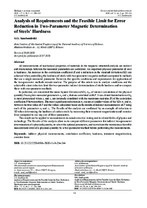| dc.contributor.author | Sandomirski, S. G. | |
| dc.coverage.spatial | Минск | ru |
| dc.date.accessioned | 2020-09-18T12:17:10Z | |
| dc.date.available | 2020-09-18T12:17:10Z | |
| dc.date.issued | 2020 | |
| dc.identifier.citation | Sandomirski, S. G. Analysis of Requirements and the Feasible Limit for Error Reduction in Two-Parameter Magnetic Determination of Steels’ Hardness = Анализ условий и достижимого предела снижения погрешности двухпараметрового магнитного определения твёрдости сталей / S. G. Sandomirski // Приборы и методы измерений : научно-технический журнал. – 2020. – Т. 11, № 3. – С. 236-244. | ru |
| dc.identifier.uri | https://rep.bntu.by/handle/data/79282 | |
| dc.description.abstract | All measurements of mechanical properties of materials in the magnetic structural analysis are indirect and relationships between the measured parameters are correlated. An important physical parameter of steel is hardness. An increase in the correlation coefficient R and a reduction in the standard deviation (SD) are achieved when controlling the hardness of steels with two-parameter magnetic methods compared to methods that use a single measured parameter. However, the specific conditions and requirements for application of the two-parameter methods remain unclear. The purpose of this article was to analyze conditions and the achievable error reduction limit for two-parameter indirect determination of steels hardness and to compare those with one-parameter methods. In particular, we considered the mean Square Deviation (SD), σF , of indirect calculation of the physical quantity F using two measured parameters x1 and x2 that are correlated with F. It was found that reduction of σF is most pronounced when x1 and x2 are inversely correlated with the maximum modulus |R| of the correlation coefficient R between them. The most significant reduction in σF occurs at similar values of the SDs σ1 and σ2 between the true value of F and the values calculated based on the results of indirect measurements of F using each of the parameters x1 and x2 . The Results of the analysis are confirmed by an example of reduction in SD when determining the hardness of carbon steels by measuring their remanent magnetization and coercive force compared to use any one of these parameters. This result can be applied to measurements in non-destructive testing and in related fields of physics and technology. The Results of the analysis allow us to compare different parameters for indirect two-parameter determination of a physical quantity, to select the optimal parameters, and to evaluate the minimum achievable measurement error of a physical quantity by a two-parameter method before performing the measurements. | ru |
| dc.language.iso | en | ru |
| dc.publisher | БНТУ | ru |
| dc.title | Analysis of Requirements and the Feasible Limit for Error Reduction in Two-Parameter Magnetic Determination of Steels’ Hardness | ru |
| dc.title.alternative | Анализ условий и достижимого предела снижения погрешности двухпараметрового магнитного определения твёрдости сталей | ru |
| dc.type | Article | ru |
| dc.identifier.doi | 10.21122/2220-9506-2020-11-3-236-244 | |
| local.description.annotation | Все измерения физико-механических свойств материалов в магнитном структурном анализе являются косвенными, а связи между параметрами имеют корреляционный характер. Важным физическим параметром стали является твёрдость. Исследователи добились повышения коэффициента R корреляции и снижения среднего квадратичного отклонения при контроле твёрдости сталей двухпараметровым магнитным методом по сравнению с однопараметровым. Но оптимальные условия применения двухпараметрового метода остаются не установленными. Целью статьи являлся анализ условий и достижимого предела снижения погрешности двухпараметрового косвенного определения твёрдости сталей по сравнению с однопараметровым. Исследовано среднее квадратичное отклонение σF косвенного определения физической величины F с использованием двух параметров x1 и x2 , корреляционно связанных с F. Получено, что эффект снижения σF сильнее всего проявляется при обратной корреляционной связи между x1 и x2 с максимальным модулем |R| коэффициента R корреляции между ними. Наиболее существенное снижение σF имеет место при близких величинах средних квадратичных отклонений σ1 и σ2 между истинными значениями F и значениями, рассчитанными по результатам косвенных измерений F с использованием каждого из параметров x1 и x2 . Результаты анализа подтверждены примером снижения среднего квадратичного отклонения определения твёрдости углеродистых сталей по результатам измерения их остаточной намагниченности и коэрцитивной силы по сравнению с использованием любого из этих параметров. Область применения результата – измерения в неразрушающем контроле и смежных областях физики и техники. Результаты анализа позволят выбрать оптимальные параметры для косвенного двухпараметрового определения твёрдости сталей, оценить достижимую погрешность определения твёрдости. | ru |

